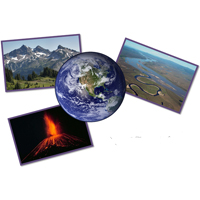The Rock Cycle – A Fun Learning Activity

To most people a rock is just a rock, nothing noteworthy or special, but to a geologist rocks are puzzle pieces full of evidence about the history of our planet. This blog post explains the rock cycle and contains a simple activity demonstrating how the three main types of rock on Earth form – with chocolate!
The rock cycle
Deep within the Earth temperatures are high enough to actually melt rock, turning it from a solid to a liquid. This molten rock is called magma and is the very beginning of the rock cycle.
Magma reaches the Earth’s surface when volcanoes erupt, and spew lava (what we call magma when it is outside of a volcano) over the existing landscape. How

ever, sometimes the magma does not make it all the way to the Earth’s surface, we call this an intrusion. Either way, the magma gradually cools down and solidifies, forming an igneous rock.
The Earth’s surface is a pretty harsh place for a rock. It is constantly beaten by wind and rain, it might be pounded by waves, smoothed by rivers or walked on over and over again by passers-by. These scenarios, and many more, all cause rocks to be gradually broken down in a process called erosion.
The broken pieces of rock are collectively called sediments and may range in size from pebbles to sand grains. Some of these sediments will be transported to a new location by rivers or the wind where they are deposited and put down forever. Over millions of years, layers of sediment will be deposited on top of one and other, and gradually the weight of all this sediment leads to compaction of the lower layers, pushing them together and causing the sediment to cement itself together. This is how a sedimentary rock is formed.
Sometimes rocks continue to become buried by more and more sediment. Such deep burial exposes the rocks to high temperatures and pressures. These conditions cause the minerals within the rocks to alter chemically, and the features within the rocks to change shape. Rocks altered in this way are called metamorphic rocks.
With continued burial and exposure to higher temperatures the rocks will eventually melt forming magma, and the cycle can start all over again.
The Choc Cycle Activity
You will need:
- 200g Chocolate

- 115g Mini Mashmallows
- 75g Coco Pops or Rice Krispies
- Oven Proof Dish
- Oven
- Hob or Microwave
- Spatula
- Cheese Grater
- Baking Paper
Step 1: Igneous Rocks
 The first step is to create some magma by melting all of the chocolate. I did this using a heat proof bowl over a pan of simmering water on the hob, however, you can melt the chocolate in the microwave if you prefer.
The first step is to create some magma by melting all of the chocolate. I did this using a heat proof bowl over a pan of simmering water on the hob, however, you can melt the chocolate in the microwave if you prefer.
Next pour your melted chocolate onto a slightly tilted smooth surface covered in baking paper (I used a tray) and allow it to flow, like lava which has erupted from a volcano.
You can get creative here! I added some geologists observing the lava flow, but you could use any edible additions to make your volcanic eruption scene more realistic.
Allow your lava flow to cool so that you have a solid igneous choc rock!
Step 2: Sedimentary Rocks
The erosive power of a cheese grater. CC-BY-science made simple
Next you need to expose your chocolate rock to the harsh conditions of the Earth’s surface, or in this case, a cheese grater!
Erode your rock and turn it into chocolate ‘sediment’.
Your sedimentary rock will be made up of three different sedimentary layers: chocolate sediment, cocoa pop sediment and marshmallow sediment.
Each one will be transported to the oven proof dish and deposited there, where it will be buried by the next sediment.
You should now see layers of sediment, just like the layers preserved in the sedimentary rocks that make up the Grand Canyon!
Step 3: Metamorphic Rocks
This step requires a little more imagination than the previous steps. You cannot add enough sedimentary layers to generate enough heat and pressure to alter our ‘sedimentary rock’. We need an oven to do this for us.
Place it in the oven at 100°C for approximately 20 minutes.
Then remove it and before it cools down use a spatula to squash and fold the mixture over to one side of the dish. You should find that the marshmallow layer has started melting and stretches out as you move it around.
This folded, misshapen feature looks quite a lot like those found in metamorphic rocks.
Now all that remains is to eat it!




